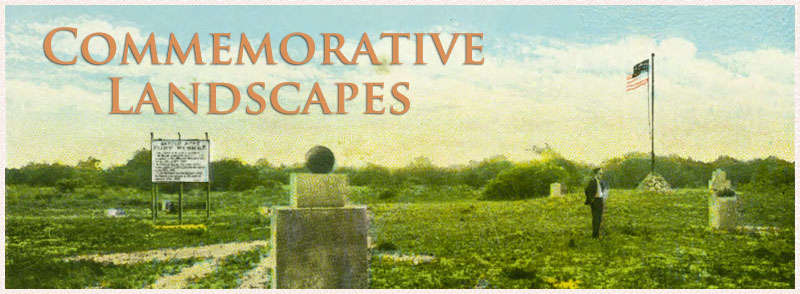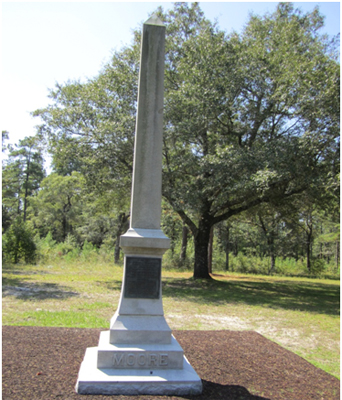
Moores Creek Moore Monument, Moores Creek National Battlefield
This tall (13’ x 4 ¾”) granite obelisk serves to commemorate James Fulton Moore, the first president of the Moores Creek Monumental Association. A bronze plaque on the east face bears the inscription. Below the plaque on the base reads “Moore” in capital letters. On the reverse, James Fulton Moore’s name is inscribed in a semicircle with his birth and death dates listed below. The choice of an obelisk for the monument reflects the cultural fascination with Ancient Egypt during the nineteenth century. Since its origins in Ancient Egypt, the obelisk has been seen as a symbol of reverence, dominance, and patriarchy.
Images:
Inscription East Face |
Inscription West Face
East face: ON THIS FIELD / THE AMERICANS WON THEIR FIRST / DECISIVE VICTORY OVER / THE BRITISH ALLIES / AND THROUGH THE EFFORTS OF / HON. JAMES FULTON MOORE / FIRST PRESIDENT OF THE / MOORE’S CREEK BATTLE GROUND / ASSOCIATION / IT HAS BECOME A NATIONAL / RALLYING GROUND FOR LOYAL / REVOLUTIONARY DESCENDANTS / AND IN HIGH APPRECIATION OF / HIS SERVICES FOR 14 YEARS / THIS SHAFT IS ERECTED IN HIS MEMORY /
MOORE
West face: JAMES FULTON MOORE / FEB. 14, 1852 / JULY 11, 1912
Moores Creek National Battlefield, National Park Service
1913
34.505830 , -78.163330
View in Geobrowse
Blakenship, Jamie. "Background Study on Fences and Monuments at Moores Creek National Battlefield," (Currie, NC: National Park Service, 1989), accessed December 6, 2012 Link
Bloodworth, Mattie. History of Pender County, North Carolina, (Richmond, V.A. : Dietz Printing Co., ca. 1947), accessed December 6, 2012 Link
Capps, Michael A., and Davis, Steven A. "Moores Creek National Battlefield: An Administrative History," (Atlanta, GA: U.S. Dept. of the Interior, National Park Service, Southeast Regional Office, Cultural Resources Stewardship, 1999), accessed December 6, 2012 Link
Carraway, Gertude Sprague. [Scrapbook of clippings and other material dealing with the Moore's Creek battleground celebration and North Carolina's part in the Sesqui-Centennial Exposition at Philadelphia], (1926), accessed December 6, 2012 Link
Chevalier, Jean, et al. The Penguin Dictionary of Symbols. (London: Penguin Books, 1982)
Hatch, Charles. "Moores Creek National Military Park, North Carolina: the Battle of Moores Creek Bridge," (Washington, D.C.: Office of History and Historic Architecture, 1969), accessed December 6, 2012 Link
Hawes, E. A., Moore, J. F., and Thomas, Charles R. "Ceremonies at the unveiling of the monument upon Moore's Creek battle ground to the women of the Revolution, August, 1907," ([Pender County, N.C.: Moore's Creek Monument Association, 1907])
U.S. Department of the Interior. National Park Service. National Park Service National Register of Historic Places Inventory. Nomination Form "Moore's Creek National Military Park No. 66000070]," ([1976]), accessed December 6, 2012 Link
Wright, Joshua G. "Address delivered at the celebration of the battle of Moore's Creek Bridge, February 27th, 1857: by Joshua G. Wright, Esq.," (Wilmington, N.C.: Fulton & Price, Steam Power Printers, 1857), accessed December 14, 2012 Link
Yes
Granite shaft, bronze plaque, concrete base (on original, but which has since been removed)
Moores Creek Monumental Association
James Moore Monument
The monument commemorates the efforts of the Moores Creek Monumental Association's first president, James F. Moore. And according to the Gertrude Carraway scrapbook, the vote by the Association to erect the monument was unanimous. In August 1944, high winds damaged a part of the monument’s shaft and broke off a portion of the base. It was repaired by Carolina Cut Stone Company on January 29, 1945.
The monument is located at the Moores Creek National Battlefield Park, 40 Patriots Hall Dr., Currie, NC 28435. The monument stands approximately 200 feet away from the Loyalist and Patriot monuments.
The monument stands in an open field outside the earthworks and beside the walking trail.
 Know anything else about this monument that isn't mentioned here? If you have additional information on
this or any other monument in our collection fill out the form at the Contact Us link in the footer. Thank you.
Know anything else about this monument that isn't mentioned here? If you have additional information on
this or any other monument in our collection fill out the form at the Contact Us link in the footer. Thank you.

